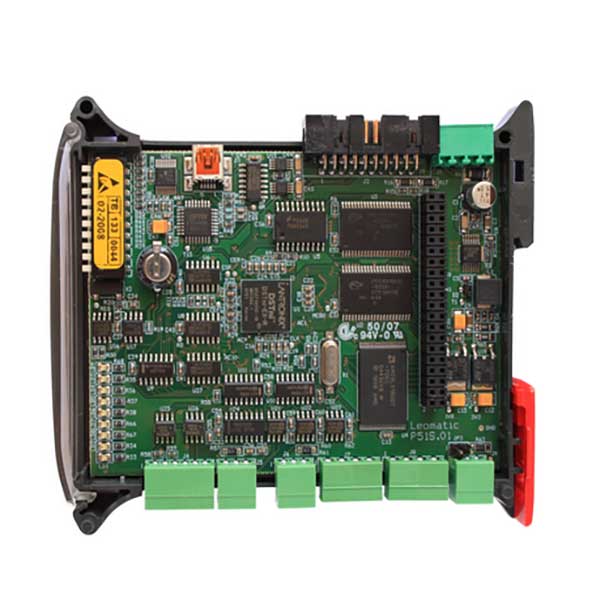
System5 P51S
CPU enhanced Leomatic System5
DIN rail module
DIN rail module
The LEOMATIC P51S module is expressly designed to manage high performance control systems based on SYSTEM5 electronics. It integrates the functions of a PLC and of a CNC, allowing the total control of very complex and/or fast automatic machines. The wide range of communication interfaces makes it the ideal front-end to external devices such as PC and Operator Panels.
The connection with the other modules of the SYSTEM5 family is extremely simplified both in the case of compact local architectures (using a 20-pole flat cable) and in the case of remote and/or distributed architectures (using a twisted pair).
The PLC logic programmed by the user is able to manage all the resources of the connected modules and to control the activities of the motor-axes.
Leomatic provides, free of charge, with its P51S modules a software suite that includes: technical manuals, Dll libraries, ActiveX modules. It allows, by the customer himself, the quick and easy development of a software application for Windows PC according to his needs.
The software suite also includes the following utilities:
- – Automation Builder: a PLC programmer to edit / compile / download a PLC control logic;
- – PncTool: a supervision tool to configure / verify / test the whole PNC system or its single modules.

System5 P51S
CPU enhanced SYSTEM5 DIN rail moduleproduct information
- Efficient multi-tasking scheduler for managing:
- PLC logic programmed by the user(PLC task);
- machining cycles with interpolations up to 6 simultaneous axes(CNC task);
- storage of parameters and data (recipes, machine settings, electronic cams, working cycles);
- dialogue with other SYSTEM5 modules and with external devices (e.g. PC-Host and an Operator Panel) through selectable protocols: LEOMATIC proprietary (BPMU, XFer) or standard such as MODBUS, MEWTOCOL, ... or finally PLC oriented;
- machine status monitoring;
- Diagnostic and test functions for field service;
- On-board firmware update directly from PC, even in the field.
- In case of failures or malfunctions a special boot firmware residing on flash memory (with reduced functionality and management of a LEOMATIC security protocol) always allows to start in recovery mode to download the application firmware from PC.
- Possibility, on request, to customize the application firmware and to implement new communication protocols towards other external devices.
- The module P51S (once programmed) provides autonomously, at each power on, the configuration of all the other connected modules. So the replacement of these last ones does not need any preliminary programming, making the maintenance operations on field extremely simple and fast.
Hardware
- 96 MHz DSTni EX-184 microprocessor.
- Memory equipment:
- 512 kbytes of volatile RAM
- 512 kbytes of retentive RAM (buffered)
- 2 Mbytes of FLASH for on-board firmware and application data.
- Parallel bus (10 MByte/s) for fast local communication with other SYSTEM5 modules.
- Four serial ports (2 RS232, 1 CANBus, 1 usable as RS232, RS422, RS485 or CANBus) for connection to other SYSTEM5 modules and/or external devices (host PC, operator panels, ...). The electrical signals of the different communication standards are carried on separate terminals.
- One USB port for connection with host PC, Operator Panel, service PC.
- Possibility to realize local architectures through the parallel bus or distributed on proprietary CANBus network.
- Possibility to realize multi-CPU systems (up to 32 P51S modules in network).
Electric
- Single power supply:
+24 Vdc nominal (min. +15 Vdc, max. +30 Vdc)
Consumption: 95 mA on +24 Vdc
Physics
Quick DIN rail mounting module
- Small size: 101 × 120 × 17.5 mm.
- Inspectionable front panel for easy access to configuration dip-switches.
- 6 signalling leds on the front panel to monitor module status and communication activities.
- Sectional terminal blocks with screw connection for power supply and communication ports.
In connection with the product sheet just described, the following documentation is available:

